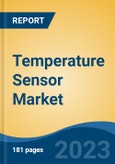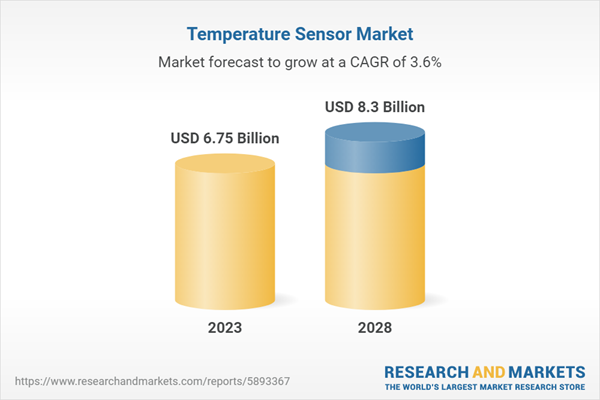Free Webex Call
The Global temperature sensor market is expected to grow at a healthy CAGR during the forecast period. An electronic device called a temperature sensor measures the temperature of its surroundings and then transforms the input data into electronic data to record, monitor, or signal temperature changes. As people become more conscious of the negative effects of undiagnosed or untreated health conditions, temperature sensors are becoming more and more common. Modern temperature sensors are now more necessary than ever and the rising popularity of wearables and fitness trackers for better patient monitoring. The need for fitness trackers is increasing due to consumers' changing lifestyles to maintain their health and lower their risk of contracting diseases. Fitness trackers measure body temperatures and keep tabs on patients' health as temperature sensors are’ necessary. Due to this, temperature sensors are frequently utilized in fitness trackers to keep track of the body's temperature both while exercising and when at rest. Speak directly to the analyst to clarify any post sales queries you may have.
10% Free customizationThis report comes with 10% free customization, enabling you to add data that meets your specific business needs.
The factors that are driving the market of temperature sensor are increasing penetration of temperature sensors in advanced and portable healthcare equipment, rising demand for temperature sensing solution in the automobile industry, uses for temperature sensing in space, increasing use of temperature control devices in managing food safety, rising incorporation of temperature sensors in consumer smart devices. However, some of the factors that are hindering the market are the high cost of sensor design and development process, and availability of alternative products.
Increasing Penetration of Temperature Sensors in Advanced & Portable Healthcare Equipment is Fueling the Market across the globe
The global market is being stimulated by the escalating use of temperature sensors in cutting-edge and portable medical equipment. In a variety of healthcare settings, from hospitals to home care, temperature sensors are essential for managing and monitoring patient health. Portable and wearable healthcare devices are growing in popularity because of the quick advancements in medical technology.Temperature sensors are frequently used in these gadgets to continuously monitor vital signs like body temperature. It gives real-time data to medical professionals, allowing for the early identification of anomalies or potential health problems. Particularly since COVID-19 pandemic, there has been an increase in demand for remote patient monitoring solutions. Early intervention is made possible, and the frequency of hospital visits is decreased. Vital signs, including body temperature, must be continuously monitored in patients with chronic diseases like diabetes, cardiovascular problems, and respiratory illnesses.
Temperature sensors built into portable medical equipment offer quick and precise temperature readings, helping to manage diseases and enhance patient outcomes. The ability to incorporate temperature sensors into more compact, lightweight, and portable medical equipment is a result of the development of miniature, highly sensitive temperature sensor. As a result, sophisticated, user-friendly, and unobtrusive medical devices that patients can wear comfortably have been developed, improving patient compliance and treatment regimen adherence. The emphasis is on early detection and intervention to stop the progression of diseases, and there is a global shift towards preventive healthcare. Individuals can regularly check their own body temperatures as temperature sensors are built into portable devices, which makes it easier to spot fevers and other unusual temperature patterns. Individuals are assisted in seeking prompt medical care and avoiding potential health complications by this proactive approach. Globally, there is a growing demand for home healthcare services due to the ageing population. With temperature sensors built into portable devices, elderly people can easily and independently monitor their body temperatures, ensuring their wellbeing and reducing the need for medical intervention.
Overall, the increasing penetration of temperature sensors in advanced and portable healthcare equipment is revolutionizing patient care by enabling continuous monitoring, early detection of health issues, and personalized healthcare management. This trend is expected to continue driving market growth across the globe.
Rising Demand for Temperature Sensing Solutions in the Automobile Industry
The rising demand for temperature sensing solutions in the automobile industry can be attributed to several factors. Temperature sensors play a crucial role in ensuring optimal performance, safety, and efficiency of various automotive systems. Temperature sensors are used to monitor engine coolant temperature, oil temperature, and intake air temperature. Accurate temperature measurements help the engine management system optimize fuel injection, ignition timing, and air-fuel ratio, resulting in improved engine performance, fuel efficiency, and reduced emissions. Temperature sensors are vital components in climate control systems, such as air conditioning and heating systems in vehicles. They monitor cabin temperature, allowing the system to adjust the airflow, temperature, and fan speed to maintain a comfortable environment for occupants. With the growing adoption of electric vehicles (EVs) and hybrid vehicles, temperature sensors are crucial for battery management systems. They monitor the temperature of the battery cells, ensuring they stay within the optimal operating range for efficient charging, discharging, and overall battery performance. Proper temperature management helps extend the battery's lifespan.Temperature sensors are used to monitor exhaust gas temperatures in vehicles equipped with diesel engines or advanced emission control systems. This information helps optimize exhaust gas treatment systems, such as diesel particulate filters and selective catalytic reduction, for effective emission control and compliance with environmental regulations. Temperature sensors are employed to monitor transmission fluid temperature and differential temperatures in the drivetrain. By monitoring these temperatures, the vehicle's control systems can ensure proper lubrication, prevent overheating, and optimize performance and longevity of transmission and drivetrain components. Some tire pressure monitoring systems utilize temperature sensors to monitor tire temperatures. Elevated temperatures can indicate potential tire issues, such as underinflation or overloading, helping improve safety and reduce the risk of tire failure. Established companies with greater financial resources and expertise may dominate the market due to their ability to invest in sensor design and development. This can create a barrier for smaller or newer players trying to enter the market, further consolidating the industry and reducing overall competition.
Overall, temperature sensing solutions in the automobile industry are in high demand due to their crucial role in optimizing engine performance, climate control systems, battery management, emission control, drivetrain monitoring, and tire safety. As automotive technologies continue to advance, the demand for accurate and reliable temperature sensors is expected to grow further.
High cost of Sensor Design and Development Process Hinder the Market
The high upfront costs associated with sensor design and development act as a barrier to entry for new companies or startups looking to enter the temperature sensor market. The expenses involved in research, prototyping, testing, and manufacturing can be prohibitive, limiting the number of players in the market. Moreover, the high costs incurred during sensor design and development are often passed on to the end consumers. This can impact the overall market demand and adoption of temperature sensors.Overall, the high cost of sensor design and development processes can hinder the market for temperature sensors by creating barriers to entry, impacting pricing, reducing competitiveness, limiting customization and innovation, restricting market expansion, and favoring established players.
Market Segmentation
Based on type, the market is segmented into thermocouple, thermistor, resistance temperature detector (RTD), semiconductor temperature sensor, infrared temperature sensor, and others. Based on output, the market is further bifurcated into digital and analog. Based on vertical, the market is further split chemical & petrochemical, oil & gas, metal & mining, power generation, food & beverage, automotive, medical, aerospace & military, consumer electronics, and others. The market analysis studies the regional segmentation to devise regional market segmentation, divided among North America, Europe, Asia-Pacific, South America, and Middle East & Africa.Company Profiles
Siemens AG, Panasonic Corporation, Texas Instruments Incorporated, Honeywell International Inc., ABB Ltd, Analog Devices Inc., Fluke Process Instruments, Emerson Electric Company, STMicroelectronics, and Microchip Technology Incorporated are among the major players that are driving the growth of the global temperature sensor market.Report Scope:
In this report, the global Temperature Sensor market has been segmented into the following categories, in addition to the industry trends which have also been detailed below:Temperature Sensor Market, By Type:
- Thermocouple
- Thermistor
- Resistance Temperature Detector (RTD)
- Semiconductor Temperature Sensor
- Infrared Temperature Sensor
- Others
Temperature Sensor Market, By Output:
- Digital
- Analog
Temperature Sensor Market, By Vertical:
- Chemical & Petrochemical
- Oil and Gas
- Metal and Mining
- Power Generation
- Food and Beverage
- Automotive
- Medical
- Aerospace and Military
- Consumer Electronics
- Others
Temperature Sensor Market, By Region:
- Asia-Pacific
- China
- Japan
- India
- Australia
- South Korea
- North America
- United States
- Canada
- Mexico
- Europe
- United Kingdom
- Germany
- France
- Spain
- Italy
- Middle East & Africa
- Israel
- Turkey
- Saudi Arabia
- UAE
- South America
- Brazil
- Argentina
- Colombia
Competitive Landscape
Company Profiles: Detailed analysis of the major companies present in the global Temperature Sensor market.Available Customizations:
With the given market data, the publisher offers customizations according to a company’s specific needs.This product will be delivered within 1-3 business days.
Table of Contents
1. Service Overview
2. Research Methodology
5. Global Temperature Sensor Market Outlook
6. North America Temperature Sensor Market Outlook
7. Asia-Pacific Temperature Sensor Market Outlook
8. Europe Temperature Sensor Market Outlook
9. South America Temperature Sensor Market Outlook
10. Middle East & Africa Temperature Sensor Market Outlook
11. Market Dynamics
13. Company Profiles
15. About the Publisher & Disclaimer
Companies Mentioned (Partial List)
A selection of companies mentioned in this report includes, but is not limited to:
- Siemens AG
- Panasonic Corporation
- Texas Instruments Incorporated
- Honeywell International Inc.
- ABB Ltd.
- Analog Devices Inc.
- Fluke Process Instruments
- Microchip Technology Incorporated
- Emerson Electric Company
- STMicroelectronics
Table Information
| Report Attribute | Details |
|---|---|
| No. of Pages | 181 |
| Published | October 2023 |
| Forecast Period | 2023 - 2028 |
| Estimated Market Value ( USD | $ 6.75 Billion |
| Forecasted Market Value ( USD | $ 8.3 Billion |
| Compound Annual Growth Rate | 3.5% |
| Regions Covered | Global |









